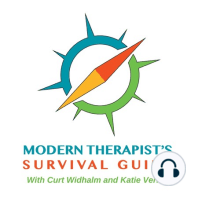38 min listen

What Maslow Missed in his Hierarchy of Needs - The Native Self Actualization Model: An Interview with Dr. Sidney Stone Brown
FromThe Modern Therapist's Survival Guide with Curt Widhalm and Katie Vernoy
What Maslow Missed in his Hierarchy of Needs - The Native Self Actualization Model: An Interview with Dr. Sidney Stone Brown
FromThe Modern Therapist's Survival Guide with Curt Widhalm and Katie Vernoy
ratings:
Length:
59 minutes
Released:
Aug 8, 2022
Format:
Podcast episode
Description
What Maslow Missed in his Hierarchy of Needs - The Native Self Actualization Model: An Interview with Dr. Sidney Stone Brown Curt and Katie interview Dr. Sidney Stone Brown on the Native Self-Actualization Model. We look at Abraham Maslow’s work, which was created after spending time with the Blackfoot people as well as how his Hierarchy of Needs supports greed and capitalism. We also talk through indigenous wisdom and how Dr. Brown incorporated their lifestyle and teachings into her work on the Native Self-Actualization Model. She emphasizes the power of altruism, reciprocity, and working together collaboratively. Transcripts for this episode will be available at mtsgpodcast.com! An Interview with Dr. Sidney Stone Brown, LPC Sidney Stone Brown was born in Kalispell Montana, and is an enrolled member of the Blackfeet Indian Nation of Browning Montana. She was raised on / near her reservation until 1955, living in her great grandmother’s log house with her parents, great uncle, brother and older sisters. They had no running water or indoor toilets; the house was heated with oil and light by kerosene lanterns until 1950. Dr. Brown’s family relocated to Coos Bay Oregon when their reservation faced termination in 1955. Thereafter Dr. Brown attended west coast schools. She attended 30 different schools between first grade and graduation at Oregon State University in 1974. Dr. Brown worked her way through college and was employed by her tribe as an employment counselor, where she met a resident psychologist working at the tribal Hospital and became interested in Psychology. Near completion of her master’s program she contracted with 1) the University of Minnesota developing community action teams for the Red Cliff Reservation, 2) a Lakota CAP agency in Rapid City South Dakota acting alcohol program director and 3) the University of Utah (Montana Wyoming) Alcohol Counselor Trainer and 4) became permanent employment as director of NARA 1974. The program was originally funded at $81,000 and in ten years was 1.2 million. NARA (1981) won a national recognition award for program excellence and it was noted at the presentation in New Orleans that the model (Native Self Actualization) she developed was the most innovative cross-cultural model ever submitted to the National Council on Alcoholism since the awards began in 1946. She has served on many other non-profit boards, appointed a member of the (ADAMHA) Alcohol and Drug Abuse Mental Health Administration Minority Advisory Committee (1974-1976). She lobbied for Indian and minority services at the Oregon State Legislature subcommittees, and before the US Senate. she helped form the board and helped develop the certification criteria for NW Indian Alcohol Drug Counselor Certification Board. In 1989 she shifted her career emphasis from administration to clinical services receiving 3 years of clinical supervision at a community mental health center and a residential treatment center to obtain licensure (LPC and NCC-MAC). Later she was mentored to be a CQI coordinator when employed at a JCAHO certified facility in Newberg Oregon. The program won re-accreditation with accommodation the second year of my employment. She was admitted to the spiritual/psychology integration program at George Fox University George Fox for fall 2001. Her clinical work with Native people convinced her she had to understand the impact of religion abuse and abuse by clergy. She is committed and determined to fulfill her goals to mentor the next generation of minority students and contribute to the literature and research that supports good practices for Native Americans. In this podcast episode, we talk about The Native Self-Actualization Model Most of us learn Maslow’s Hierarchy of Needs, but did not hear the story about his time with the Blackfoot Tribe. There is more and more evidence that he took Native teachings and transformed it to match our individualistic, capitalistic society. We reached out
Released:
Aug 8, 2022
Format:
Podcast episode
Titles in the series (100)
Asking for Money: Curt and Katie talk about setting fees, taking payments, credit card charges, and Bitcoin by The Modern Therapist's Survival Guide with Curt Widhalm and Katie Vernoy